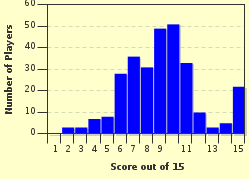Quiz Answer Key and Fun Facts
1. The Roman occupation of Britain lasted from 41 - 410 CE. During this time many new foodstuffs were introduced. What was considered a special delicacy that might have been served at a Roman banquet?
2. What major food/beverage production was originally introduced during the Roman occupation?
3. With the withdrawal of the Romans in 410 BE, German tribes moved into Britain. What type of important fishery did they introduce?
4. 1066, the Norman invasion, was a defining moment in British History, unifying all the smaller Kingdoms and introducing French customs and language. What important census was conducted in 1086, that gave a picture of the amount of arable land and numbers of people and domestic animals extant in Britain at the time?
5. What would have been the staple foods of the majority of the population in the 11th Century?
6. In the 12th, 13th and 14th centuries there is considerable written evidence of the formation of food guilds and the introduction of recipe books. Herring smoking was developed, hop beers introduced and sugar imported from the Levant.
In the mid 14th Century, what was the major setback to life in Britain and Europe?
7. The Sixteenth Century saw the discovery of the New World and circumnavigation of the Earth. It also saw the introduction of the first English printed cookery book:- 'A Noble Booke of Cokery'. What year was this first published?
8. What was one of the most important foodstuffs that was introduced to Britain from the New World?
9. The 17th century saw the expansion of British trade both to the West and the East. All manner of new food items and spices became readily available, including Strawberries from Virginia and Lime juice in barrels from the West Indies, improving the health and eating habits of the general population. There was, however, one item developed in the 1670s that changed the drinking habits of the country. What was this innovation?
10. In the first part of the 18th Century we see the introduction of fancy desserts from France and a recipe for Ice Cream appears in 1718 in "Mrs Mary Eales Receipts". However as the century progressed, one harvest after another failed, pushing up the price of grain. In addition, poisonous adulterants were beginning to appear in everyday food. To relieve the problem, which of these measures had the most important impact on food distribution
11. In 1815 the Corn Laws were passed, raising the price artificially high. This led to great unrest among agrarian workers. What was the devastating result of these high prices and crop failures, including the Great Irish Potato Famine.
12. The Industrial Revolution in Britain also produced the beginnings of a merchant or middle class. Who was the greatest influence upon their Style of cooking?
13. What was the long term impact of the industrial revolution upon the poor, as they were crammed into cities?
14. From the 19th Century onwards, what perpetuated the bad reputation held by British food?
15. When did the British start throwing away their tins and begin to eat fresh?
Source: Author
Englizzie
This quiz was reviewed by FunTrivia editor
Bruyere before going online.
Any errors found in FunTrivia content are routinely corrected through our feedback system.


